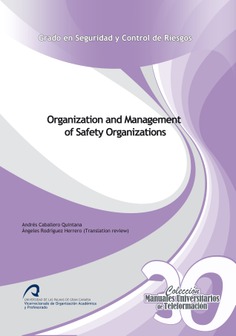
Organization and Management of Safety Organizations
Andrés Caballero Quintana (Escritor) , Ángeles Rodríguez Herrero (Traductora)
Safety requires organizations that manage effectively and efficiently, whether public or private. This manual provides tools to make this possible. It combines theory, techniques and practices to learn how to structure organizations in the safety and risk management sector, including strategies, objectives, indicators, quality systems, knowledge management, marketing, audits and evaluations.
La seguridad requiere de organizaciones que gestionen eficaz y eficientemente, sean públicas o privadas. Este manual ofrece herramientas para hacerlo posible. Combina teoría, técnicas y prácticas para aprender a estructurar organizaciones del sector de la seguridad y el control de riesgos, lo que incluye estrategias, objetivos, indicadores, sistemas de calidad, gestión del conocimiento, marketing, auditorías y evaluaciones.
- Escritor
- Andrés Caballero Quintana
- Traductora
- Ángeles Rodríguez Herrero
- Colección
- Manuales Universitarios de Teleformación. Grado en Seguridad y Control de Riesgos
- Materia
- Cuestiones de seguridad pública
- Idioma
- English
- EAN
- 9788490423264
- ISBN
- 978-84-9042-326-4
- Depósito legal
- GC 698-2017
- Páginas
- 262
- Ancho
- 21 cm
- Alto
- 29 cm
- Edición
- 1
- Fecha publicación
- 22-02-2018
- Número en la colección
- 30
Precio
Contenidos
PRESENTATION
INTRODUCTION TO THE SUBJECT
LEARNING UNIT 1. GENERAL PRINCIPLES OF THE ORGANIZATION
PRESENTATION
OBJETIVES
SCHEME OF THE CONTENTS
EXPOSURE OF THE CONTENTS
1. Introduction
1.1. Types of organization according to its purpose
1.2. Dimensions of security and emergency organizations
1.3. Areas of action of the organizations
2. Approaches to the organization theory
2.1. Classic approaches
2.2. Neoclassical approaches
2.3. Contemporary approaches
3. Organizational structures, management and administration
3.1. Key items
3.2. Models of organizational structures
4. The jobs
5. Organizational culture
6. The management of the organizational change
7. Public and private organizations
8. The creation of administrative structures
ACTIVITIES
BIBLIOGRAPHY
SELF-EVALUATION EXERCISES
SOLUTIONS TO SELF-EVALUATION EXERCISES
COMPLEMENTARY MATERIALS
GLOSSARY OF TERMS
LEARNING UNIT 2. THE MANAGEMENT OF SECURITY
AND EMERGENCY ENTITIES
PRESENTATION
OBJETIVES
SCHEME OF THE CONTENTS
EXPOSURE OF THE CONTENTS
1. Legal requirements of the companies, head, director and department of security
1.1. Security companies
1.2. Heads and Directors of Security
1.3. The Security Departments
2. The access, promotion and mobility of local policmen in the canary islands
3. Infoca
4. Plateca
5. Basic elements of the management of security and emergency entities
5.1. Objectives and indicators
5.1.1. Specific goal template
5.2. The strategic direction
5.2.1. Strategic analysis
5.2.2. Strategic analysis and planning: the SWOT technique
5.2.3. The Strategic Planning
5.2.4. Strategic implementation and control
5.3. Analysis of the competition and the positioning of the organization in its sector
5.4. Strategic classification of products or services: the BCG matrix of growth and participation
5.5. Components of the quadrants of the BCG matrix
5.6. Project management
5.7. Project Cycle Management and Logical Framework
ACTIVITIES
BIBLIOGRAPHY SELF-EVALUATION EXERCISES
SOLUTIONS TO SELF-EVALUATION EXERCISES
COMPLEMENTARY MATERIALS
GLOSSARY OF TERMS
LEARNING
UNIT 3. QUALITY MANAGEMENTPRESENTATION
OBJETIVES
SCHEME OF THE CONTENTS
EXPOSURE OF THE CONTENTS
1. Historical origins
2. Definitions
3. Principles of total quality and continuous improvement
4. Why is a quality management system needed?
5. Process management
5.1. The agents and the classification of the processes
5.2. Flowcharts
5.3. Redesign of processes
6. Models and quality management standards
6.1. Certification and assurance
6.2. The ISO 9000 standards
6.2.1. Principles
6.2.2. Documentation
6.2.3. Stages of implementation ISO 9001 2015 Standard
6.3. FQM model
6.3.1. Introduction
6.3.2. The model
6.3.3. Stages for the development of self-evaluation
6.3.4. RADAR Logic
6.4. Other standards of interest for quality management
7. Some tools for quality management
7.1. Brainstorming
7.2. The survey (Polls)
7.3. The Matrix of Priorities
7.4. The interview
7.5. The data collection sheet
7.6. Histogram
7.7. Cause - Effect Diagram or Ishikawa diagram
ACTIVITIES
BIBLIOGRAPHY
SELF-EVALUATION EXERCISES
SOLUTIONS TO SELF-EVALUATION EXERCISES
COMPLEMENTARY MATERIALS
GLOSSARY OF TERMS
LEARNING UNIT 4. MARKETING IN SECURITY AND EMERGENCY ENTITIES
PRESENTATION
OBJETIVES 3
SCHEME OF THE CONTENTS
EXPOSURE OF THE CONTENTS
1. Marketing guidelines
2. Marketing functions
3. The marketing plan
3.1. Phases of the marketing plan
3.1.1. Analysis of the situation
3.1.2. Defining Corporate Objectives
3.1.3. Marketing strategy
3.1.4. Program of actions of marketing
3.1.5. Budget
3.1.6. Control and evaluation
4. The communication
5. The brand
ACTIVITIES.
BIBLIOGRAPHY
SELF-EVALUATION EXERCISES
SOLUTIONS TO SELF-EVALUATION EXERCISES
COMPLEMENTARY MATERIALS
GLOSSARY OF TERMS
LEARNING UNIT 5. KNOWLEDGE MANAGEMENT AND INTELLECTUAL CAPITAL
PRESENTATION
OBJETIVES
SCHEME OF THE CONTENTS
EXPOSURE OF THE CONTENTS
1. Introduction
2. Knowledge management
2.1. Definition
2.2. Classification
2.3. Objectives.
2.4. The effect of experience
2.5. Learning ability
2.6. Cases
3. Intellectual capital
3.1. Definition and classification
3.2. The Intelect model
3.3 Cases
ACTIVITIES
BIBLIOGRAPHY
SELF-EVALUATION EXERCISES
SOLUTIONS TO SELF-EVALUATION EXERCISES
COMPLEMENTARY MATERIALS
GLOSSARY OF TERMS
LEARNING UNIT 6. AUDIT, EVALUATION AND GOOD PRACTICES
PRESENTATION
OBJETIVES
SCHEME OF THE CONTENTS
EXPOSURE OF THE CONTENTS
1. Introduction to the audit
2. Concept of audit
3. Types of audit
3.1. Internal and external auditing
3.2. Audit of regularity, or financial, and operational, or management
3.3. Quality audit
3.4. Audit of information systems
3.5. Local security audits
4. Planning and execution of the audit
4.1. Phases or stages of the audit
4.1.1. Preliminary Phase (previous planning)
4.1.2. Planning phase: preparation and review of the audit plan
4.1.3. Execution phase
4.1.4. Reporting phase
4.1.5. Post-Reporting Phase
5. Introduction to the evaluation
5.1. Historical notes
5.2. Definition: basic brushstrokes
5.3. Object
6. Concepts
7. The phases of the evaluation
8. The phases of the evaluation
8.1. Experimental, quasi-experimental and non-experimental designs
8.1.1. Experimental designs
8.1.2. Quasi-experimental design
8.1.3. Non-experimental design
8.2. Objectives and identification of indicators
8.3. Information gathering
9. Types of evaluation
9.1. Depending on the time frame of the program
9.1.1. Ex ante or previous
9.1.2. Intermediate
9.1.3. Ex post
9.2. At the discretion of the organizer of the evaluation
9.2.1. Models of effectiveness
9.2.1.1. Objective achievement models
9.2.1.2. Of side effects
9.2.1.3. Free evaluation of objectives
9.2.1.4. Customer oriented
9.2.1.5. Focus of the participant
9.2.1.6. Political commissions
9.3. Procedural models
9.4. Economic models
9.4.1. Evaluation of productivity
9.4.2. Efficiency
9.5. Professional models
9.6. According to the criterion of who carries out the evaluation
9.7. Other evaluations
9.7.1. Evaluation of evaluability
9.7.2. Evaluation of the design / conceptualization of the program
9.7.3. Evaluation of the implantation
9.7.4. Evaluation of results
9.7.5. Impact evaluation
9.8. Tools to evaluate .
9.8.1. Methods of quantitative analysis
9.8.2. Methods of qualitative analysis
9.8.3. Purposes of the evaluation
9.8.4. Interests and criteria
10. Best practice
ACTIVITIES
BIBLIOGRAPHY
SELF-EVALUATION EXERCISES
SOLUTIONS TO SELF-EVALUATION EXERCISES
COMPLEMENTARY MATERIALS
GLOSSARY OF TERMS
GRAPH AND TABLES INDEX



